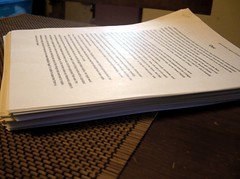 In the first and second posts in this series, I talked about style guides. Today we’ll discuss style sheets. A comment from author Dawn Colclasure gave me the idea for the post.
In the first and second posts in this series, I talked about style guides. Today we’ll discuss style sheets. A comment from author Dawn Colclasure gave me the idea for the post.
You might call style sheets mini style guides that you prepare yourself, often as supplement to a style guide. There are always things, such as industry jargon and names, that apply to a specific manuscript that aren’t covered in the style guide you’re using. In some cases, there may be a reason for deviating from the style guide, such as using a spelling that is common in the industry even though it’s different from your selected style guide.
The book I’m currently editing is a resource for veterans and soldiers with PTSD. In different sources, the full name of the disease is spelled Posttraumatic Stress Disorder, Post Traumatic Stress Disorder, Post-Traumatic Stress Disorder, posttraumatic stress disorder, post traumatic stress disorder, post-traumatic stress disorder–and about a dozen more variations. I told the authors they had to decide which one they preferred, and I would ensure it was spelled that way throughout the book. They chose the spelling used in the American Psychiatric Association’s manual of psychiatric disorders. That spelling was one of many items included in the style sheet–for my use during editing and for the use of the proofreader I had to review the manuscript.
A style sheet can be as simple or as complex as needed. In its most basic form, it should include the preferred style guide and dictionary, then list additions and deviations, such as the example excerpted below.
Style Guide: Chicago Manual of Style
Dictionary: Merriam-Webster Online
Treatment of specific words and phrases:
amygdalae
flight-or-fight response and flight-fight-freeze (hyphenated)
Posttraumatic Stress Disorder (per DSM-IV)
You can include formatting instructions in the style sheet. For example, in the PTSD book, the co-authors wanted their words set apart in different fonts so it would be easy for readers to recognize whether the psychotherapist or the chaplain/psychotherapist was talking. Of course, we identified the author at the beginning of the section, but since some sections extended over several pages, the different fonts provide a visual cue.
In What are style guides and why do I need them?, I talked about more extensive information guides. An information guide for a novel might include details about characters and setting as well as the spelling of names and hyphenation of words. When you write a book over months or even years, it’s easy to forget what you wrote 200 pages ago.
An information guide is helpful to you as the writer, and it’s also important for your editor to ensure consistency throughout the manuscript. Without a style sheet, the editor won’t know if your character’s name is Susanne or Suzanne or if she lives in Harveytown or Harvey Town.
Style sheets make it easier for everyone involved in producing a book, article, or other document, and the resulting consistency makes it easier for your reader to get your message without getting confused or bogged down in discrepancies.
Do you use style sheets? What advice would you give about using style sheets effectively?
